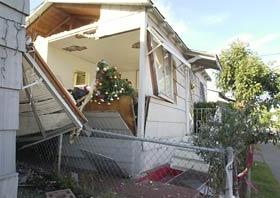Claim: Insect-infested house is destroyed when too many "bug bombs" set by owner are ignited.
Origins: In December 2003, an overly determined householder in
took on the bugs and lost her home in the process.
"Bug bombs" are aerosol insecticide foggers used to exterminate a residence's insect population,

commonly purchased in home improvement stores by those intent upon ridding their domiciles of
cockroaches, fleas, and the like. After the homeowner has cleared his house of kids, pets, and other residents, he sets off the fogger by pressing down on a tab atop the can; the "bug bomb" then begins to produce a fine mist of insecticide, continuing this "fogging" at a slow and steady rate until the canister is empty. After a few hours, the residents of the house (adults, kids, pets) can return to their (presumably) insect-free home, air it out, and take up residence again. One canister is generally sufficient for a
Nineteen of these foggers were set off in Aurelia Oliveras'
This type of accident had occurred before in San Diego. In April 2001, another fog of insecticide from eighteen bug bombs was similarly set off by a pilot light, this time blowing up an apartment in the City Heights neighborhood. No one was injured, but several cockroaches managed to survive the blast. Elsewhere in southern California, another pilot light ignited the fumes from three bug bombs set off in a
Given the force of these blasts, it's surprising more people aren't injured.
According to the California Department of Pesticide Regulation (CDPR), a number of such explosions occur every year, typically when homeowners use too many foggers and don't shut off ignition sources (particularly pilots lights in ovens, stoves, and water heaters). In this battle between man and insect, more is certainly not better. Those still contemplating the use of an arsenal of bug bombs in their wars with six-legged foes should consider this: If the possibility of a horrendous explosion doesn't talk you out of it, the fact that roaches often survive the megabombing should. Little can compare to seeing your home in ruins, its windows and walls blasted out, its roof lifted, and the whole of the house shifted off its foundation
Barbara "bombs away" Mikkelson
Update: In April 2005, various news outlets reported three men were hospitalized for burn treatment after they attempted to fumigate a Thai restaurant in Perth, Australia, with
The blast caused an estimated $500,000 damage, fire authorities said. The restaurant owner and two staff members had closed the premises to set off 36 insect-control bombs throughout the building. Eight bombs would have been enough, West Australian police and fire and emergency personnel said. Investigators believed a pilot light in one of the restaurant's ovens ignited the huge amount of chemicals released by the bombs to kill insects such as fleas and cockroaches.
A massive explosion rocked suburban Duncraig today after chemicals released during last night's do-it-yourself fumigation ignited, blowing out the back wall and lifting the roof off the Tamarind restaurant.
In January 2008, the Galveston County Daily News reported that a resident left six foggers working inside his house but neglected to extinguish the pilot lights, triggering a blast that blew the roof off the home.
Additional information:
| Warning About Bug Bombs (California Department of Pesticide Regulation) | |
| Using Insect Foggers Safely (California Department of Pesticide Regulation) |
Last updated: 22 January 2008
 Sources:
Sources:
